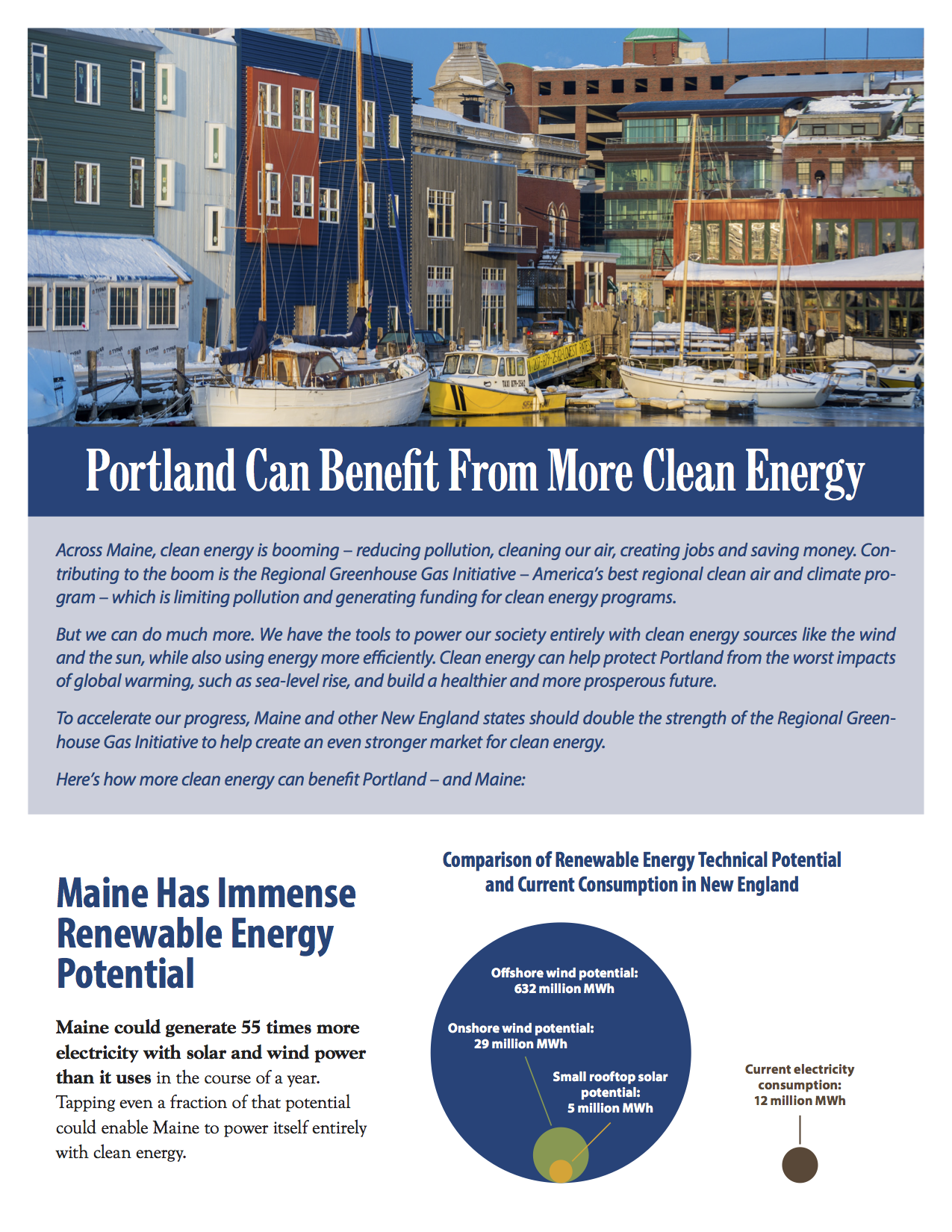Portland Can Benefit From More Clean Energy

Across Maine, clean energy is booming – reducing pollution, cleaning our air, creating jobs and saving money. Con- tributing to the boom is the Regional Greenhouse Gas Initiative – America’s best regional clean air and climate pro- gram – which is limiting pollution and generating funding for clean energy programs.
But we can do much more. We have the tools to power our society entirely with clean energy sources like the wind and the sun, while also using energy more efficiently. Clean energy can help protect Portland from the worst impacts of global warming, such as sea-level rise, and build a healthier and more prosperous future.
To accelerate our progress, Maine and other New England states should double the strength of the Regional Green- house Gas Initiative to help create an even stronger market for clean energy.
Here’s how more clean energy can benefit Portland – and Maine:
Maine Has Immense Renewable Energy Potential
Maine could generate 55 times more electricity with solar and wind power than it uses in the course of a year. Tapping even a fraction of that potential could enable Maine to power itself entirely with clean energy.
Clean Energy Can Replace Dirty Fuels
Maine has the potential to generate 140 times more electricity from wind and solar than is currently produced by polluting fuels, like gas, in the state.
Portland’s Rooftops Can Generate Clean Electricity Locally
More than 7 out of 10 small buildings in Portland have the potential to host rooftop solar panels – providing reliable electricity for residents and reducing dependence on fossil fuels, according to data from the U.S. Department of Energy.
Maine Has Tremendous, Untapped Wind Energy Potential
Maine has the potential to produce enough power with onshore and offshore wind turbines to power all of the homes in Maine more than 100 times over.
Energy Efficiency Is Saving Money and Cutting Pollution
Energy efficiency programs implemented in 2015 in Maine saved enough energy to power nearly all of the homes in Portland.
Clean Energy Creates Jobs
Ocean and wind power in Maine employ more than 3,600 workers in the state.
Renewable Energy is Good Business
Businesses and organizations in Portland and across Maine benefit from a growing clean energy economy. For example, Oxford Networks, an information technology company, added advanced efficiency technology to its data center in Maine, partially cooling the center with Maine’s brisk outdoor air. The project was made possible by the state’s energy efficiency utility, Efficiency Maine, with partial funding from the state’s participation in the Regional Greenhouse Gas Initiative. The project reduced Oxford Networks’ energy costs by as much as $5,000 per year.
Stronger Action Will Make Us Healthier
Clean air means better health. In its first six years, the Regional Greenhouse Gas Initiative saved 10 lives in Maine and prevented 770 missed work days due to respiratory illness, according to Abt Associates. Cutting pollution faster would save even more lives and improve public health in Maine.
Stronger Action Will Boost Our Economy
Between 2009 and 2014, the Regional Greenhouse Gas Initiative boosted Maine’s economy by $218 million, according to reports by Analysis Group. Doubling the strength of the program as part of a larger climate change program could reduce energy bills in the nine participating states by $25 billion and create nearly 60,000 new jobs, according to a report by the Sierra Club.
Maine Should Take the Lead
Maine has set strong goals on clean energy and fighting climate change – now it’s time to achieve them. Governor LePage should double the pace at which Maine is cutting pollution and investing in clean energy. In 2017, the state should strengthen the Regional Greenhouse Gas Initiative to cut carbon pollution by 5 percent per year – and persuade neighboring states to do the same.
Citations:
1. Pg 1: Renewable potential chart heading Renewable energy potential: National Renewable Energy Laboratory, “United States Renewable Energy Technical Potential,” 2012 for wind, 2016 for solar, available at: www.nrel.gov/gis/re_potential.html; Current consumption: U.S. Energy Information Administration, “State Electricity Profiles,” 2015, available at: www.eia.gov/electricity/state
2. Pg 2: “polluting fuels, like gas, in the state.” Renewable energy potential: Ibid., Fossil fuel generation: U.S. Energy Information Administration, “State Electric Power Industry Generation by Primary Energy Source,” 2014, available at www.eia.gov/electricity/data/state
3. Pg 2: “data from the U.S. Department of Energy.” U.S. Department of Energy, State & Local Energy Data, “Buildings and Industry Summary,” available at apps1.eere.energy.gov/sled/#
4. Pg 2: “STATE X times over.” Wind potential: see note 1; Household energy usage: U.S. Energy Information Administration, “Average Monthly Residential Electricity Consumption, Prices, and Bills by State,” available at www.eia.gov/tools/faqs/faq.cfm?id=97&t=3; Homes: U.S. Census Bureau, “Quick Facts,” available at www.census.gov/quickfacts
5. “homes in PLACE X times.” Savings: American Council for an Energy-Efficient Economy, “Net Incremental Savings From Electricity Efficiency,” 2015, available at database.aceee.org/sites/default/files/docs/spending-savings-tables.pdf; Home energy usage: Household energy usage: U.S. Energy Information Administration, “Average Monthly Residential Electricity Consumption, Prices, and Bills by State,” available at www.eia.gov/tools/faqs/faq.cfm?id=97&t=3; Homes: U.S. Census Bureau, “QuickFacts.”
6. pg 3: Maine Ocean & Wind Industry Initiative, Maine Wind Facts,accessed on 16 November 2016, archived at https://web.archive.org/web/20161116213151/http://www.mainewindindustry….
7. Pg 3: Gideon Weissman, Frontier Group and Travis Madsen, Environment America Resarch & Policy Center, Carbon-Cutting Success Stories, 2016
8. Pg 4: “due to respiratory illness.” Abt Associates, Analysis of the Public Health Impacts of the Regional Greenhouse Gas Initiative, 2009-2014, January 2017
9. pg 4: “according to reports by Analysis Group.” Analysis Group, The Economic Impacts of the Regional Greenhouse Gas Initiative on Nine Northeast and Mid-Atlantic States, First and Second Three-Year Compliance Reviews, 2011 and 2015
10. pg 4: “report by the Sierra Club.” Sierra Club, Pace Energy and Climate Center, and Chesapeake Climate Action Network, The RGGI Opportunity 2.0, 4 March 2016
